In Castrojeriz we got up very early in the morning again and it was completely dark when we left the albergue. Every afternoon, our wise Gabriel would go to check the exact route for leaving the place in which we were spending the night in order not to wander the next day. Although the Way of Saint James is generally well marked, it may happen that there is confusion so early in the day and then one may end up walking in circles. Thus, this morning, led by Gabriel and his headlamp, we easily left Castrojeriz and went on along an asphalt road.
Not far from the village there is a hill the top of which is reached by a rather steep slope. One certainly gets breathless while going up, but once there, when you stop to regain your breath and look around you, you get breathless again.
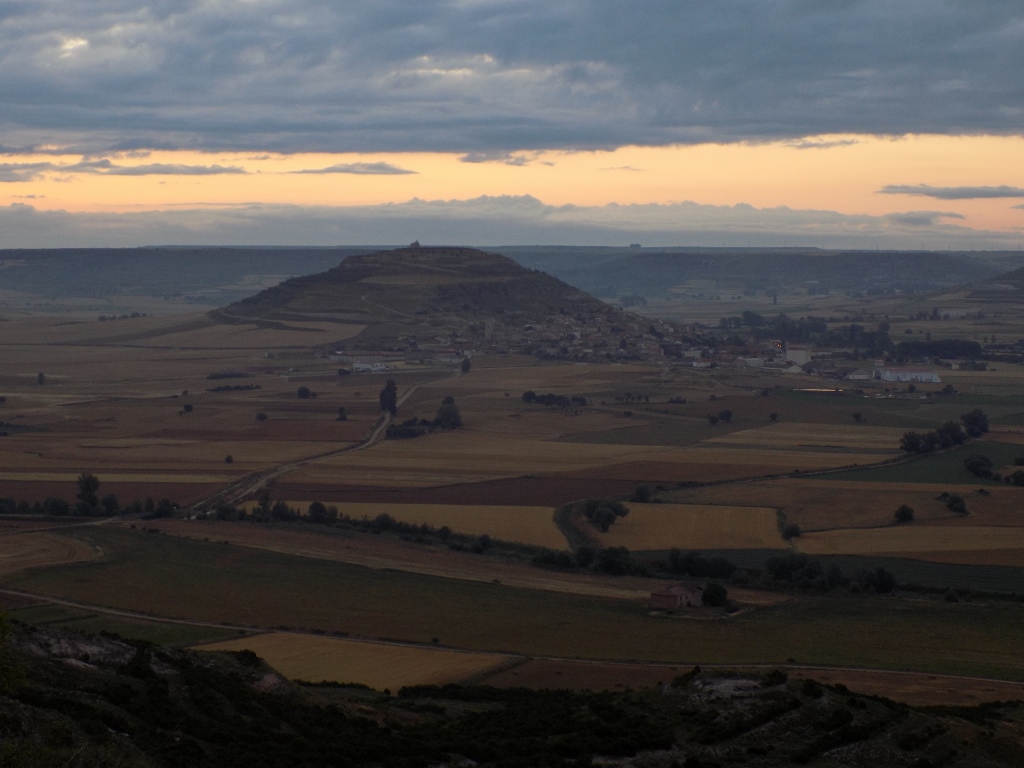 View at Castrojeriz in the dawn
View at Castrojeriz in the dawn
Of course, this morning, too, we were followed by the fabulous sounds of different birds – first we heard roosters who were crowing as we were passing through the village and then the wild birds took over.
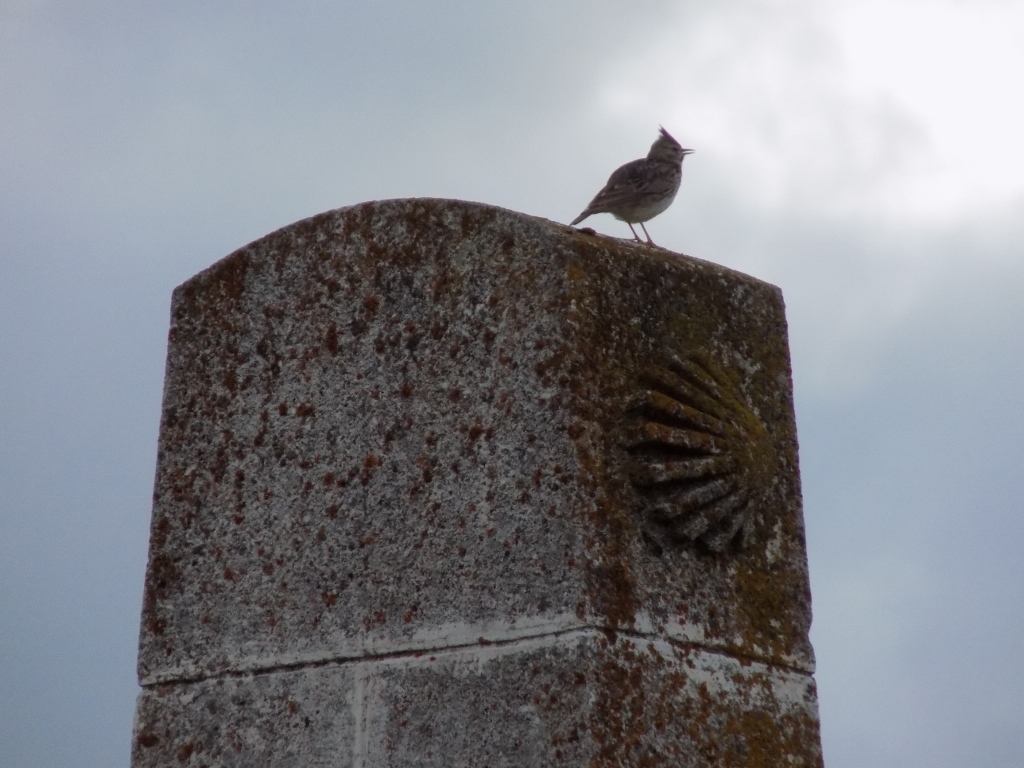 On a pillar with the symbol of the Way
On a pillar with the symbol of the Way
On the other side of the hill we faced a steep slope again, this time leading down, but we managed that well and just had to continue straight along the road. Here, there is only that main dirt road and enormous fields, so one cannot get lost. Between Castrojeriz and the next inhabited place, Itero de la Vega, there are good 11 km to cover and for me with the hurting leg again this also meant the first place where I would be able to sit down, have breakfast, apply ice and take a pill.
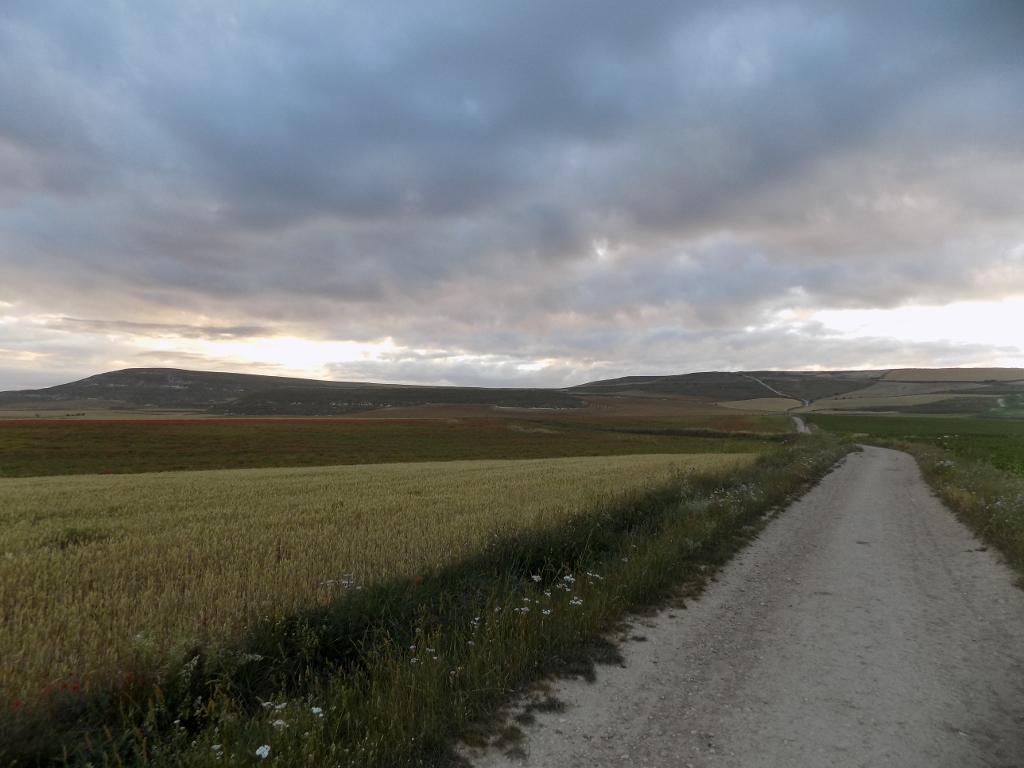 The steep hill is behind us
The steep hill is behind us
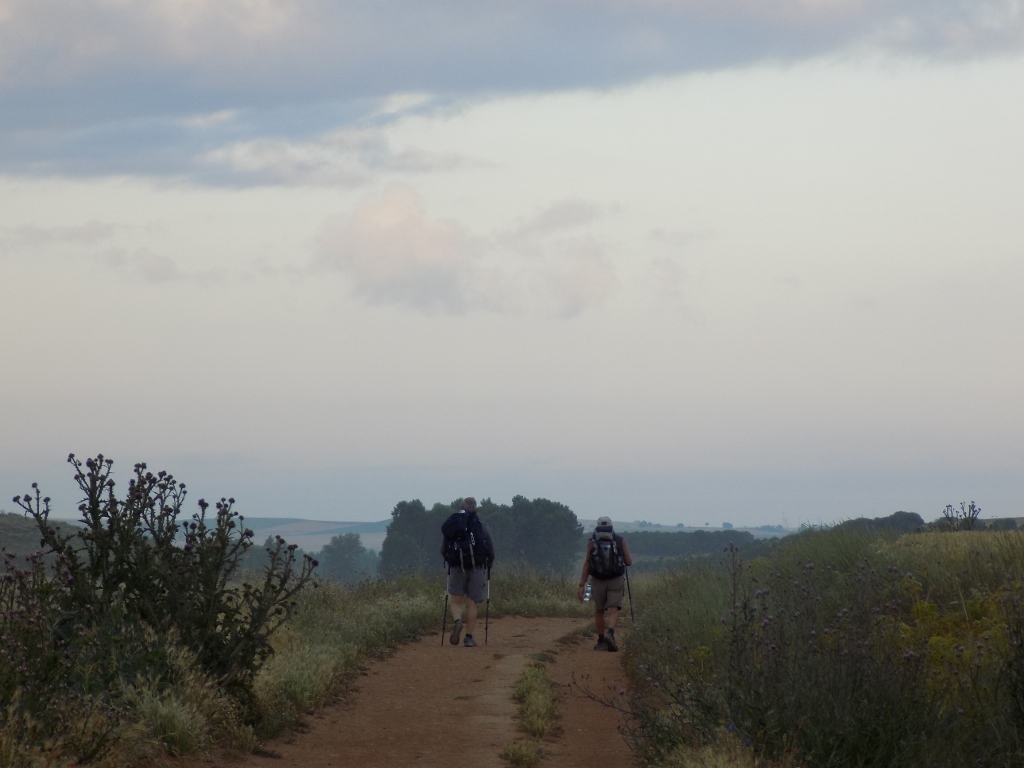 On the way to Itero de la Vega
On the way to Itero de la Vega
Before reaching the place, one has to go along Fitero bridge (Puente Fitero) over the river Pisuerga, but some hundred metres before the bridge, there is an edifice that used to serve as a hospital for pilgrims. This is the Chapel of St. Nicholas of Bridge Fitero, (Ermita de San Nicolás de Puente Fitero), which started to be built in the 12th or the 13th century. It is a simple building and today it serves as a pilgrims’ albergue.
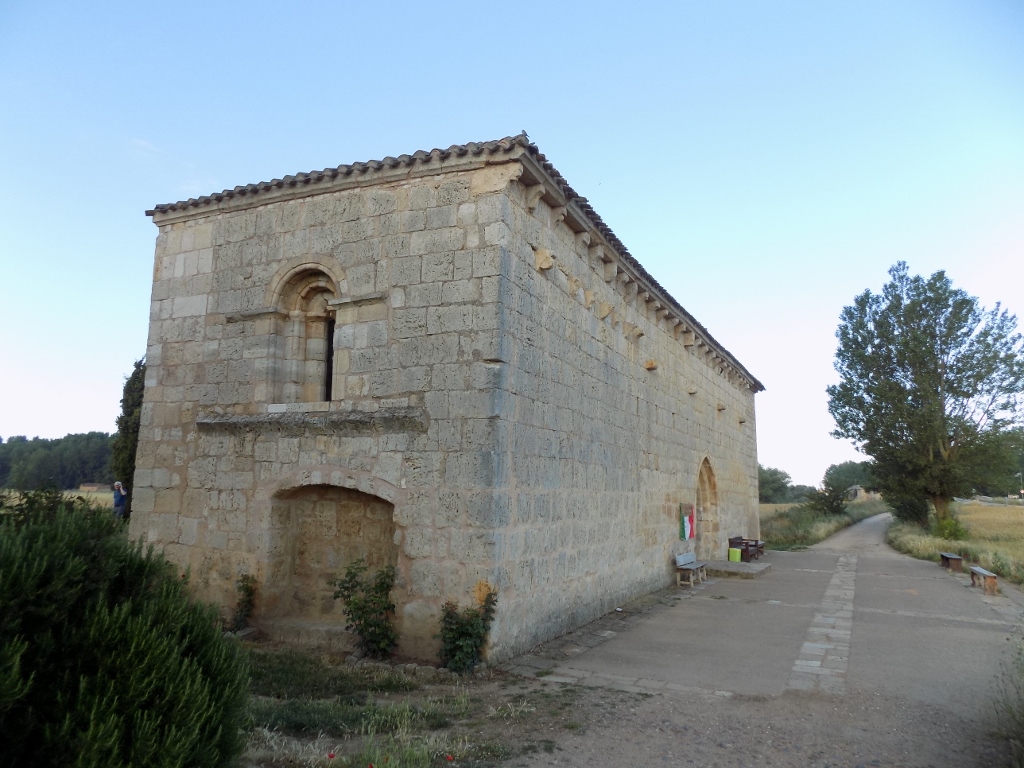 Chapel of St. Nicholas of Bridge Fitero
Chapel of St. Nicholas of Bridge Fitero
Since there was a large Italian flag displayed at the entrance, this was almost like a call for Francesco to peek inside and then I followed him myself. There we immediately saw an Italian guy whom we had encountered numerous times along the Way as he was putting his shoes on and Francesco greeted him joyfully. For me, it was more interesting that I could see the place for sleeping was provided in the area of the sanctuary and there were at the time a few people there, sleeping in their bags.
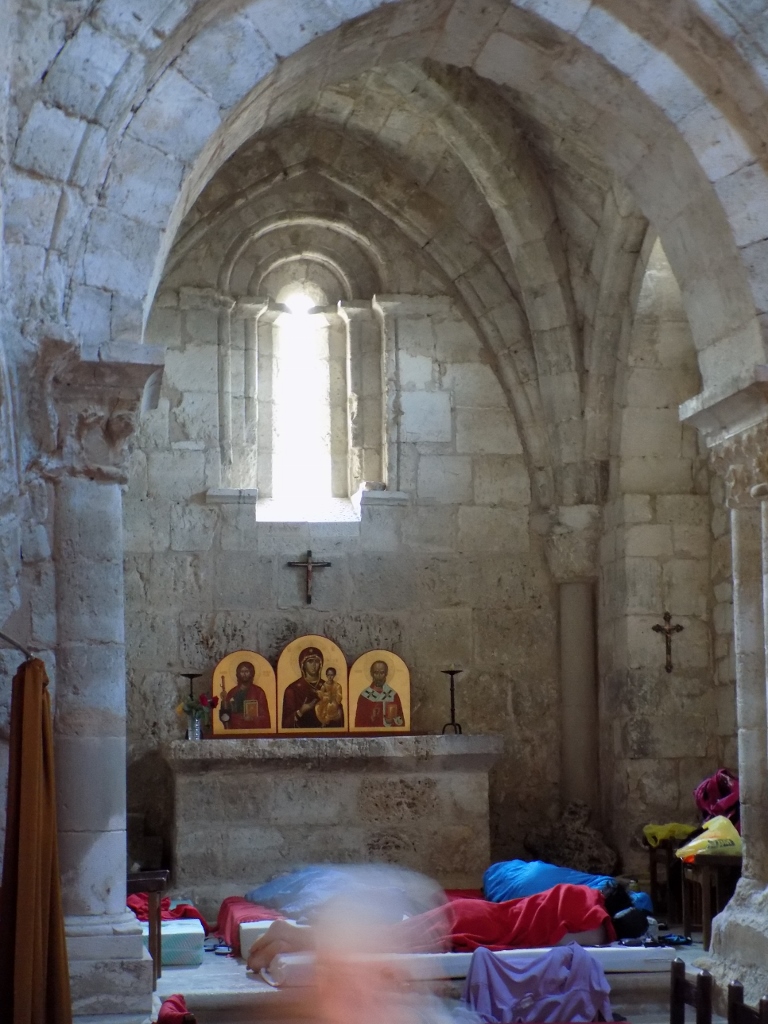 The altar space and people sleeping there in their bags
The altar space and people sleeping there in their bags
Actually, the whole interior of the hospital, i.e., of the chapel has been accommodated to the needs of contemporary pilgrims. There was a large dining table, a kitchen, as well as a notice board.
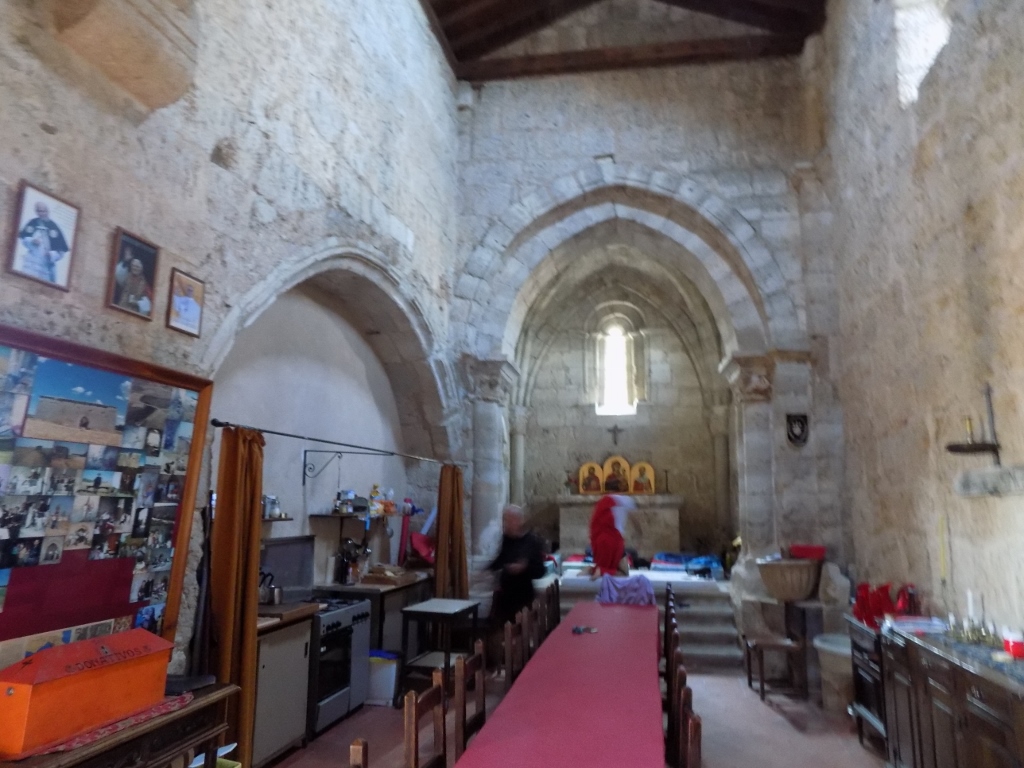 The interior of the former chapel/hospital
The interior of the former chapel/hospital
As I was taking photos trying to steady my camera in order not to have blurred pictures, I realised that one of the persons who had woken up and was just getting to her feet was – our Angela! It no longer mattered if anybody else wanted to sleep, since that was quite a loud reunion filled with joy and hugs! It was indeed completely incredible that we ran into her there. In addition, it was also completely unexpected, since Angela’s plan was to get to Santiago 4 days before us because of her return plane ticket, so we thought she was way ahead of us. Still, she is a wonderful, beautiful, good and young woman full of spirit, so I’m certain that the guys she was meeting along the Way and with whom she was walking were not too willing to let her “run away,” and that’s why she took more time during some of the stages.
Happy because of the reunion, we continued with our walk and in less than half an hour we were in Itero de la Vega where we could finally sit down to have breakfast and good rest. When we resumed our walk, at the very exit from the village we passed by an abandoned house with walled-in windows and a mural. We stopped briefly and laughed, since we said the images on the mural were like the three of us – it was just not clear what the role of the little witch visible in the shade was.
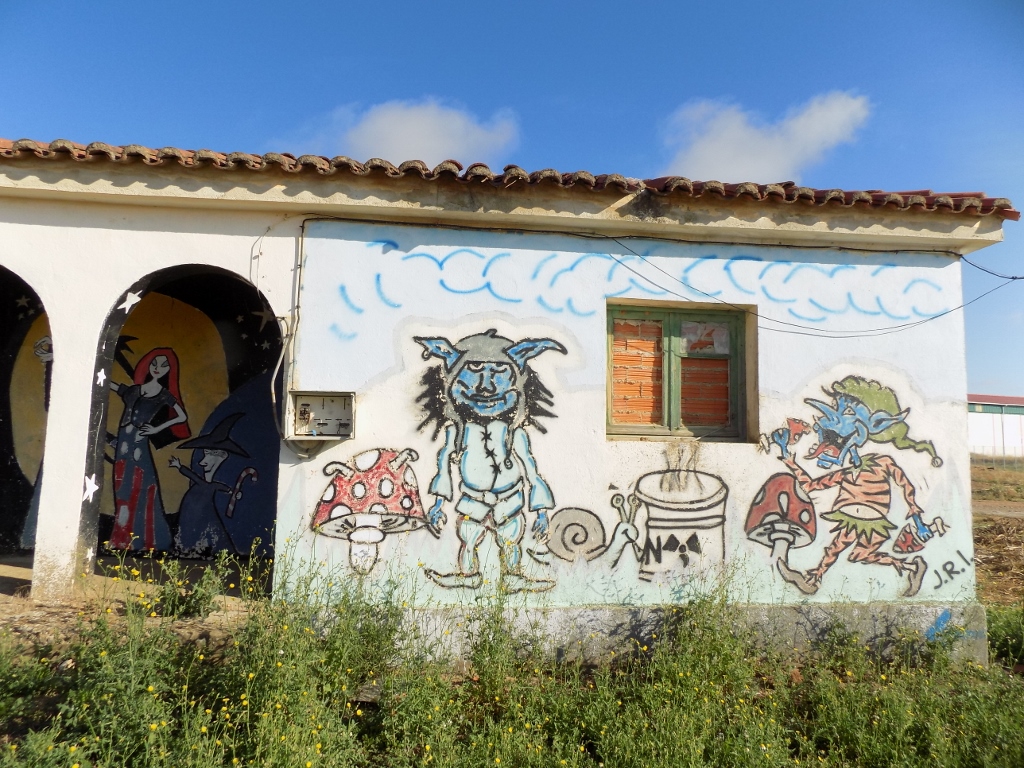 Mural at the exit from Itero de la Vega
Mural at the exit from Itero de la Vega
Then, in the scenery we were going through, enormous fields mostly with grain started to rule again. I truly enjoyed the beauty of the landscapes around me.
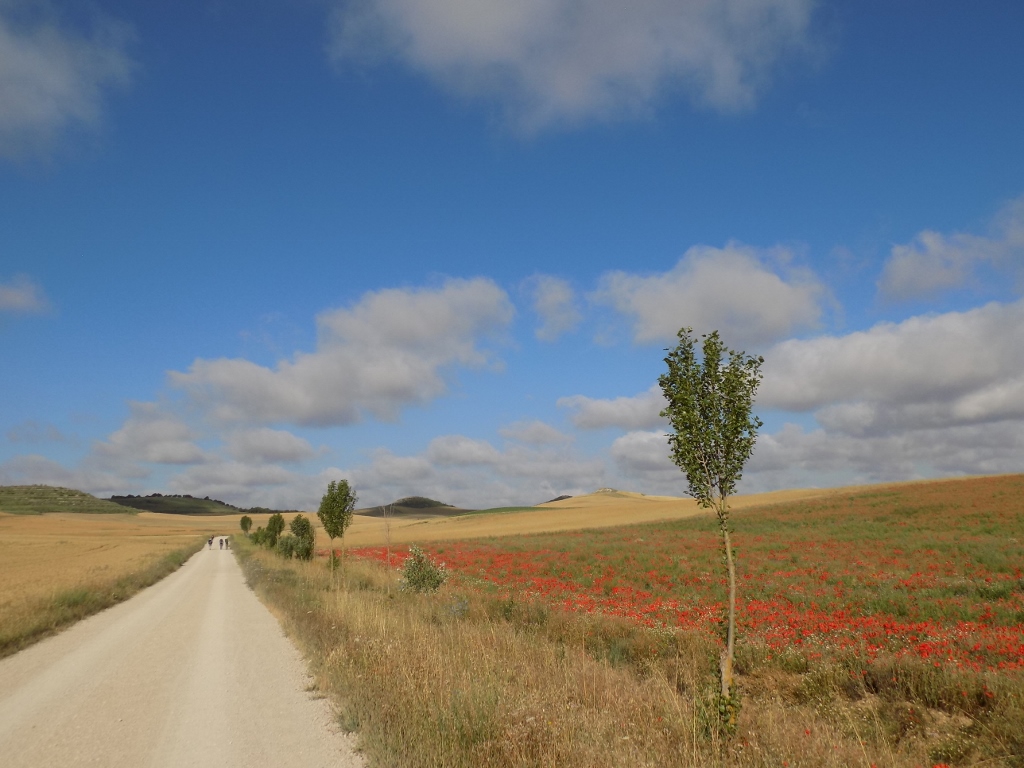 Between Itero de la Vega and Boadilla del Camino
Between Itero de la Vega and Boadilla del Camino
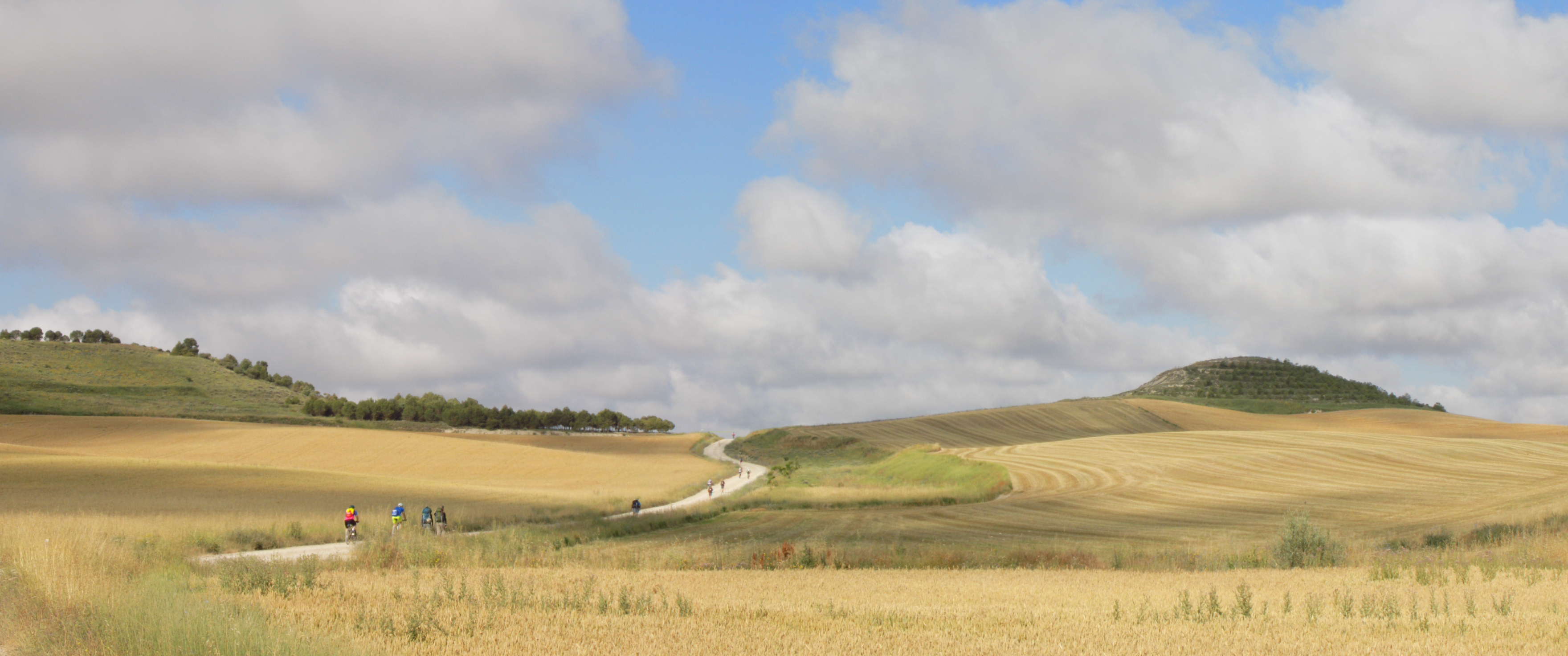
When we got to Boadilla del Camino, we noticed some storks on the top of the local church and it was Francesco who was particularly interested in them, so during the rest of our Way we continually paid attention to these birds. It may be seen that humans help them in the building of nests, by providing the platforms on which the storks then, during the construction of their home, lay down twigs.
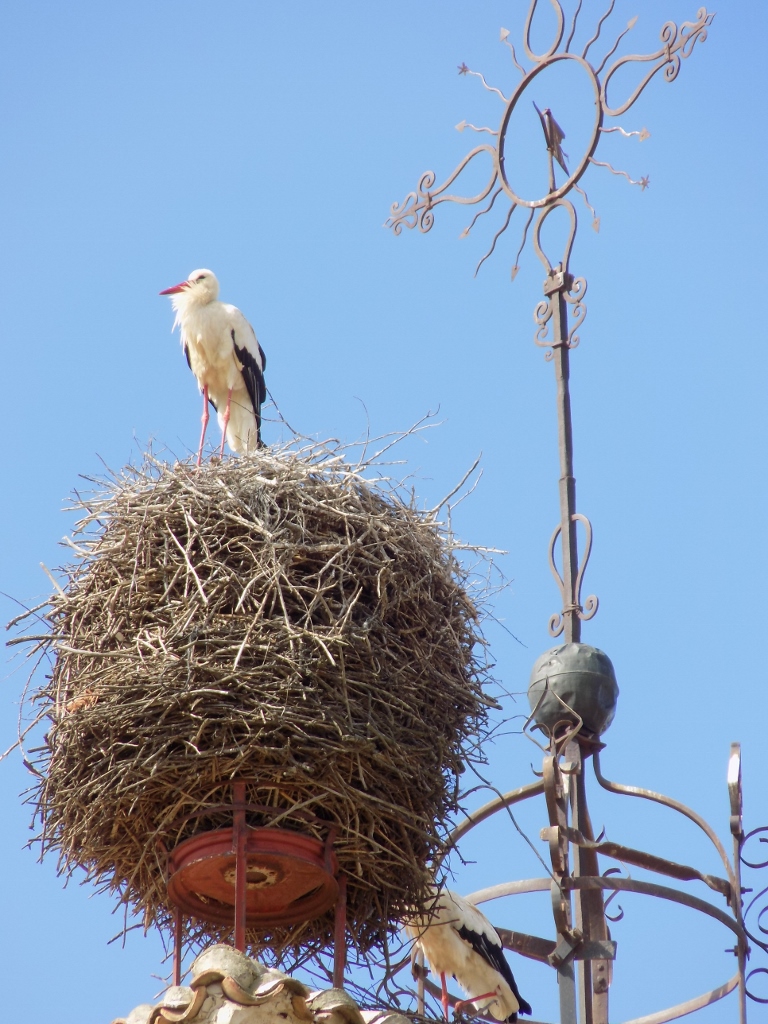 A stork nest in village Boadilla del Camino
A stork nest in village Boadilla del Camino
After this place, the landscapes changed mildly again, but kept being stunningly beautiful, while the Way led along the Canal of Castilla (Canal de Castilla). The Canal of Castilla, which is used for irrigation, was built during the second half of the 18th century and the first half of the 19th century and its total length is 207 km.
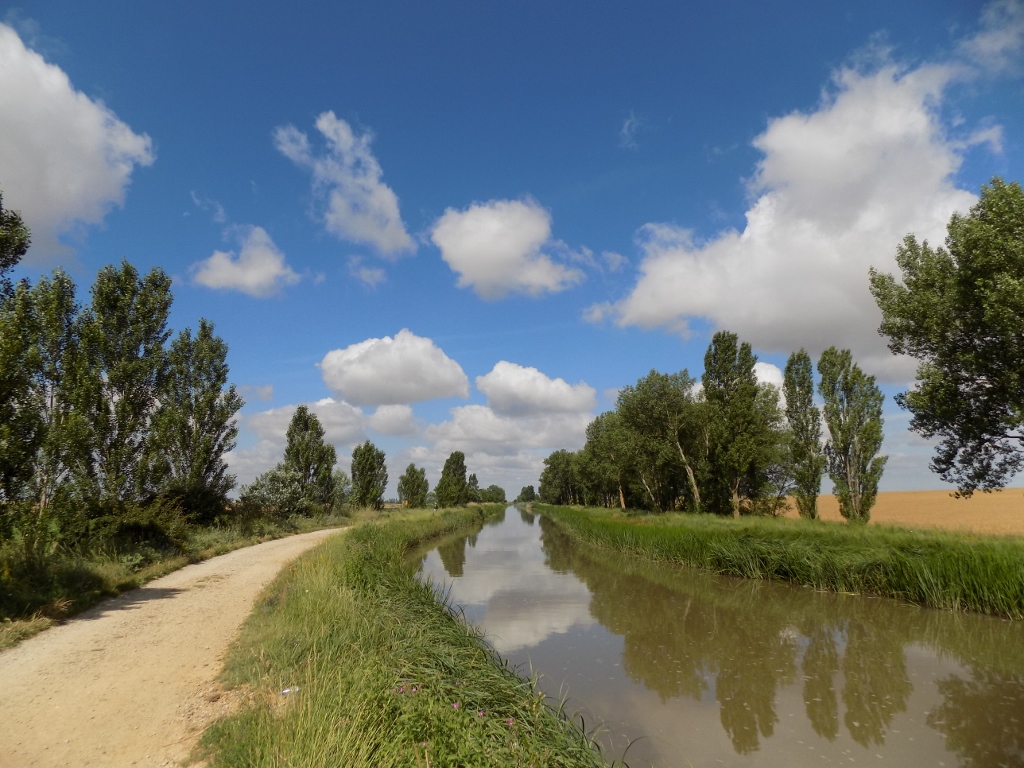 Canal of Castilla and the Way passing by it
Canal of Castilla and the Way passing by it
We walked along this canal for just a few kilometres though, frequently coming across shade, which felt very good, but we also enjoyed the wonderful sounds of the nature around us. Before reaching the town of Fromista, the canal turns at an almost right angle, but there is also a significant drop, i.e., a change in the canal levels ensured through cascades. Across the top of that cascade section, there is a pedestrian bridge and we walked across it in order to get to the nearby centre of Fromista.
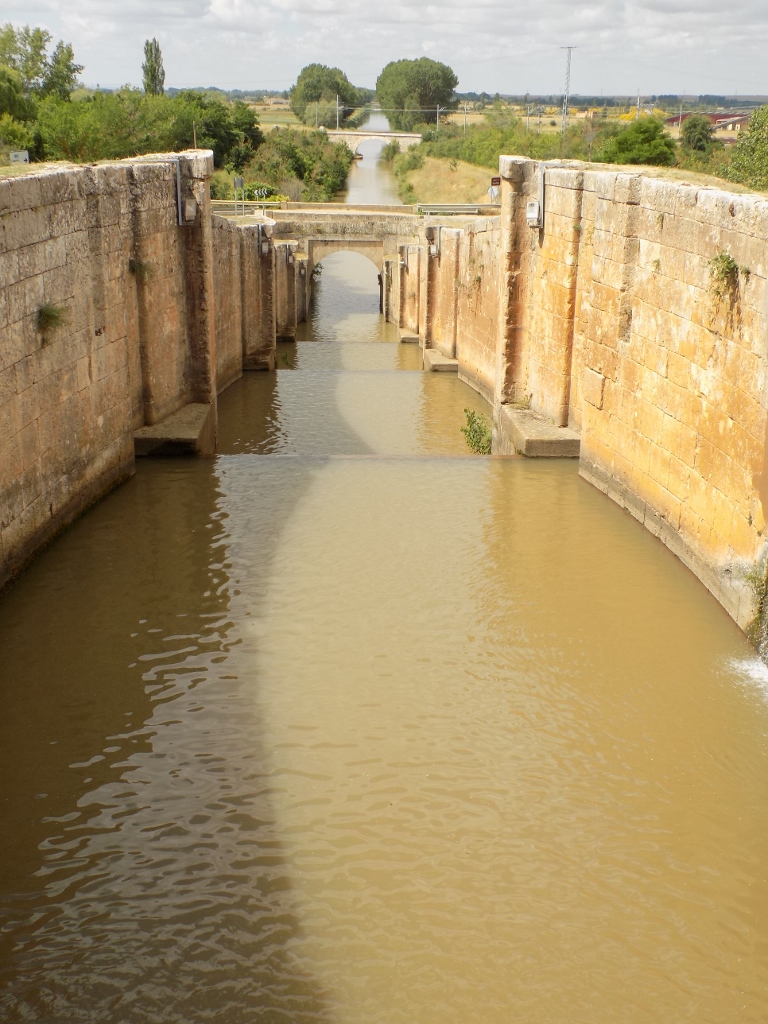 View from the bridge down the cascades near Fromista
View from the bridge down the cascades near Fromista
Since the hostel was still not opened when we got there, we first went to eat something and it felt good to sit down and get some rest. The proper rest, though, ensued a little later at the albergue when I took the opportunity to post my daily text on the internet. It was important to do it as soon as possible, because some of the hostels have a rather poor internet link and once they get full of pilgrims who start using the link, the latter becomes almost unusable. For this reason, I always tried to post my texts early in the afternoon and to finish everything that was important and that required the internet.
Day 18: “San Remo Festival on the Way”
Again leaving at the crack of dawn, but it was worth it. Soon after leaving the place there was an ascent over a slope of 12 degrees (on an average) and when you climb up, catch your breath and look around, you see that it was all worth it. Just as it was all worth it when from the mini-plateau we went down on the other side over an 18-% slope (an on average). I enjoyed myself, but at some point, my leg started to hurt again and my enjoying came to its end and all I wanted was to get to a bar at which we would sit and have breakfast. These breaks actually rest one much more than what might be presumed taking into account the brief time spent there. On the other hand, the fact is that there I apply ice and take a pain-killer, and then the pain subdues a little.
Then we moved on and again there was very nice scenery in front of me with a mild slope and I felt again that I had to stop and take photos. Still, at some point, my eyes got used to the sights around me and I really pressed on in order to catch up with my co-pilgrims.
During most of the today’s stage Francesco sang “O sole mio” or some other Italian songs and at some point I told him that one of my favourite Italian songs of all times was a song by Sergio Endrigo, but at the moment I could not recall the name of the song, so I started to sing it and Francesco joined me (https://www.youtube.com/watch?v=s3ffOkIXU_I). Neither of us knew all the lyrics, of course, but with a lot of nah-nah-nah, we brought the song to its end and it really is a wonderful song, but completely wrong. Too soft and mellow. Then Francesco, being a man of experience, remembered a much better one – “Azzuro” by Adriano Celentano (https://www.youtube.com/watch?v=HCyzGuipTd4). A great song and very appropriate for the moment, because it was almost like a march, rendering a good rhythm. We also sang that song mostly using nah-nah-nah, but it was great! And here we come to:
Lesson no. 6: “Make sure that you always have a suitable song handy!”
What I want to say is that different situations require different melodies and rhythms. When I say this, I don’t mean that one should put earphones on and all the time listen to some music completely unconnected with the setting. From time to time yes, but all the time – certainly not! I adore music and it holds a very important position in my life, and it felt absolutely great to sing anything that made us happy at the moment in time, with all the singing out of tune and the nah-nah-nah, but I believe that in the largest part of today there was nothing better for me to listen to than the sound of my treads, different bird songs, the sound of the wind in the tops of poplars or reed bushes, the croaking of frogs, the sound of chimes which some pilgrims carry around their ankles or fixed to their backpacks, the sound of Francesco’s metal water bottle that hit against a metal buckle on the backpack in the rhythm of his pace... Today was a good day, too!
In front of me: 438 km
Behind me: 429 km
Following the afternoon rest, I walked with Francesco to a nearby shop to buy some fruits, since I thought I should put into myself a vitamin or two that did not come from a pill. At the same time, I enjoyed the beauty of the Church of San Martín from the 11th century that stands on a spacious square of the same name.
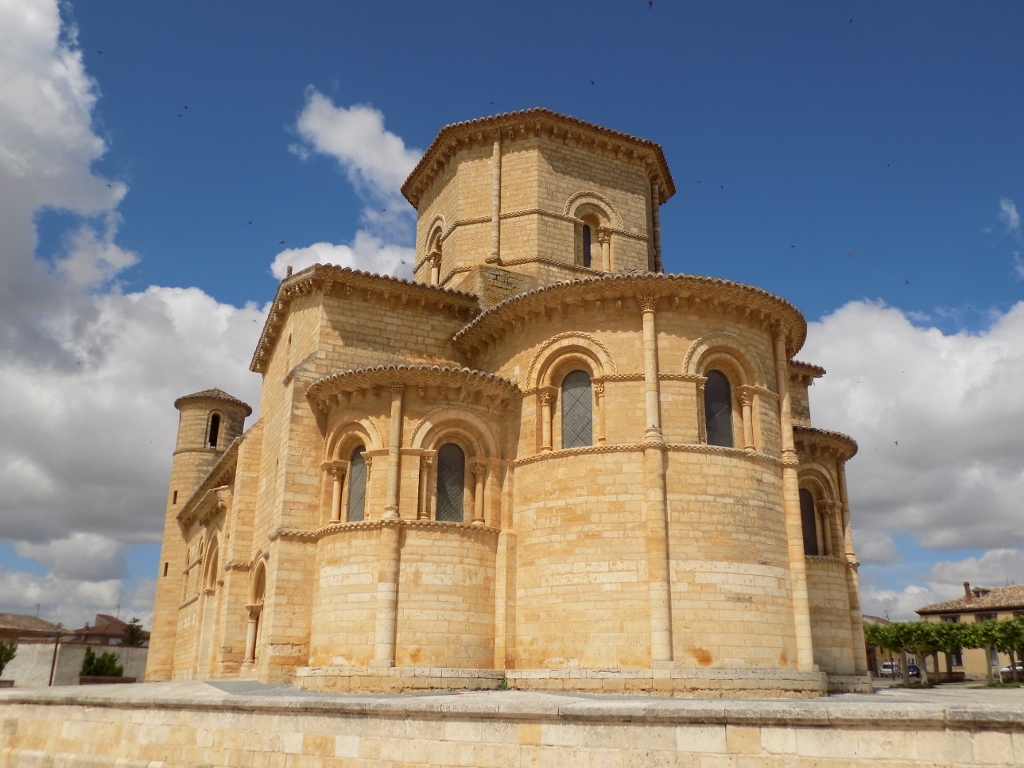 Church of San Martín
Church of San Martín
The church has been a National Monument ever since 1894 and I found particularly interesting the decorations that go under the cornice and that are called modillions, some 300 of them.
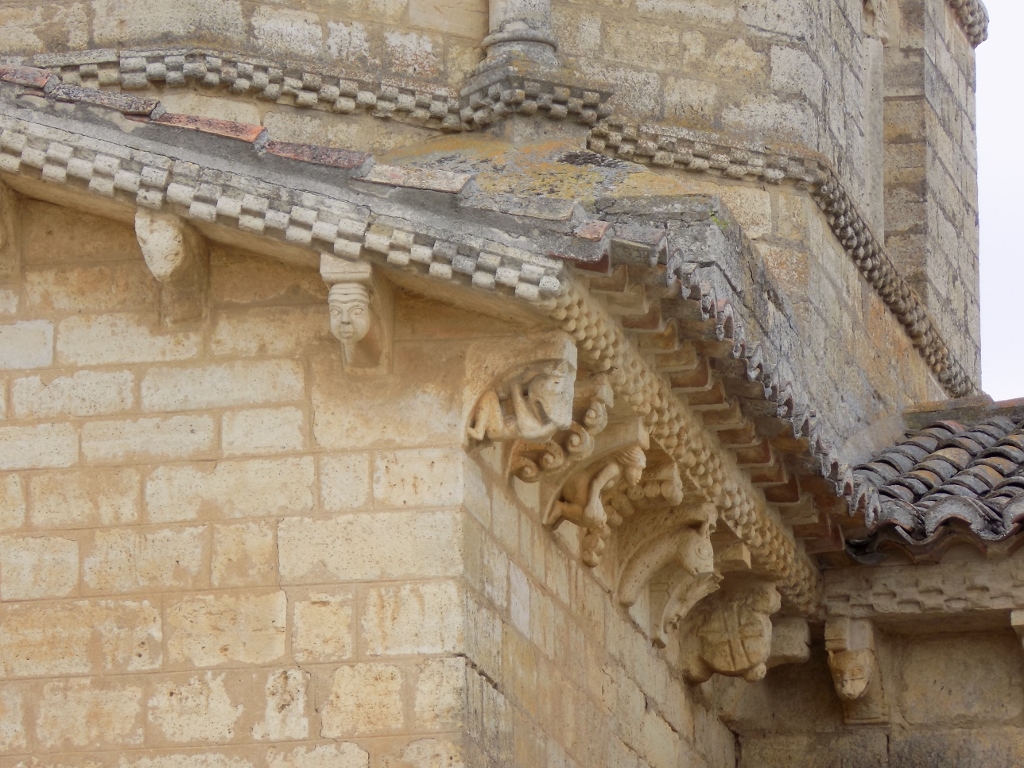 Some of the modillions at the Church of San Martín
Some of the modillions at the Church of San Martín
The next morning we did not get up too early, since the stage for that day was relatively short and we could afford to sleep a little longer.
When you leave Fromista, the Way goes parallel to an asphalt road and completely straight to the next place when there is a possibility to follow two directions. We opted for the slightly longer one, but it was more interesting because it did not go parallel to the asphalt road that had regular passing of vehicles.
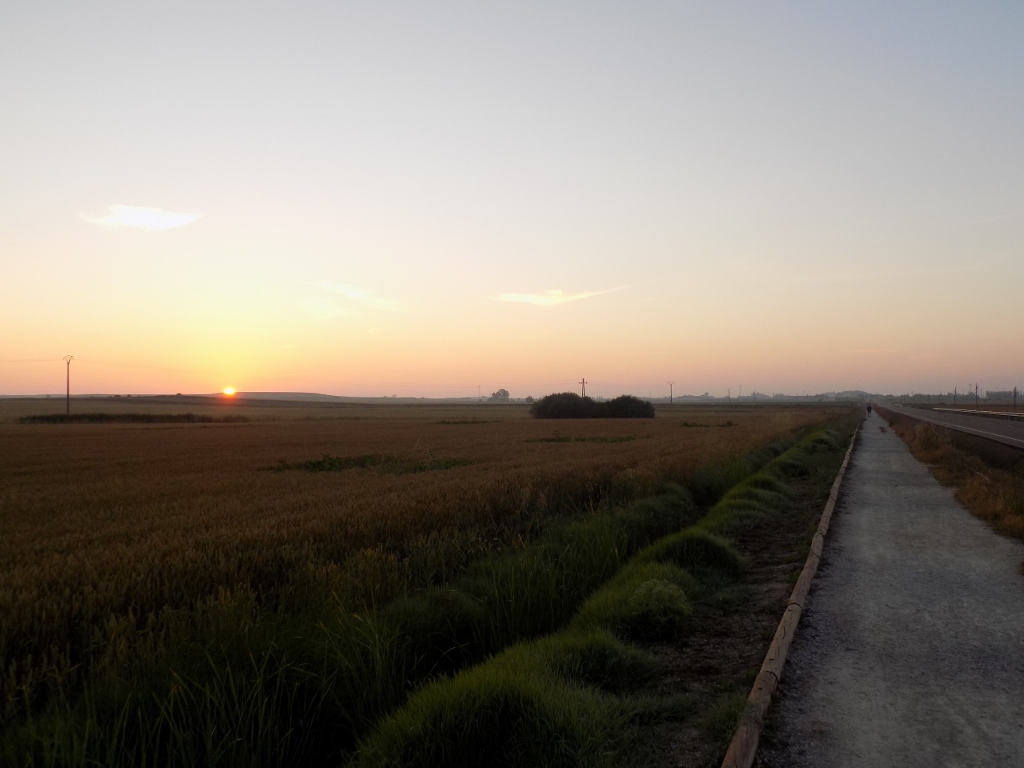 The Way in the section after leaving Fromista
The Way in the section after leaving Fromista
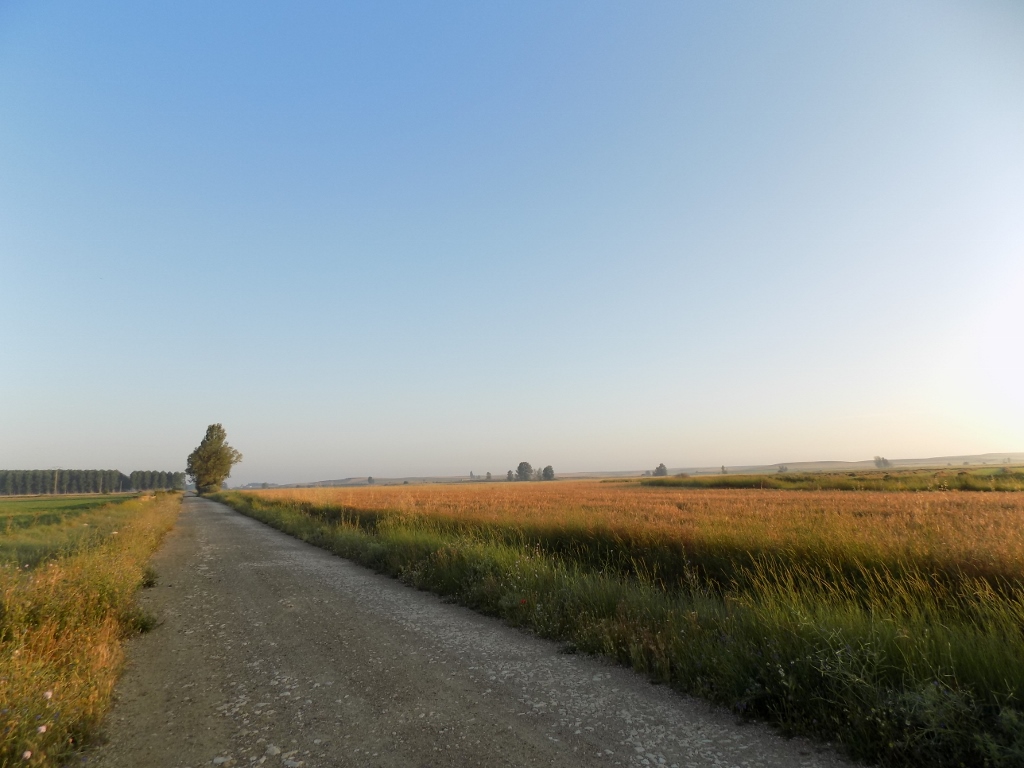 Variant of the Way that goes via Villovieco
Variant of the Way that goes via Villovieco
At one point I heard some sounds and when I looked back I could see that these were two pilgrims whose cart was pulled by a donkey. During our Way, the three of us came across them from time to time. As far as I got it (some of it I heard from other pilgrims), the two of them walked, while the donkey pulled the cart on which they carried everything they needed, including a tent, olive oil they had produced themselves, as well as other things they need. There was also their dog with them.
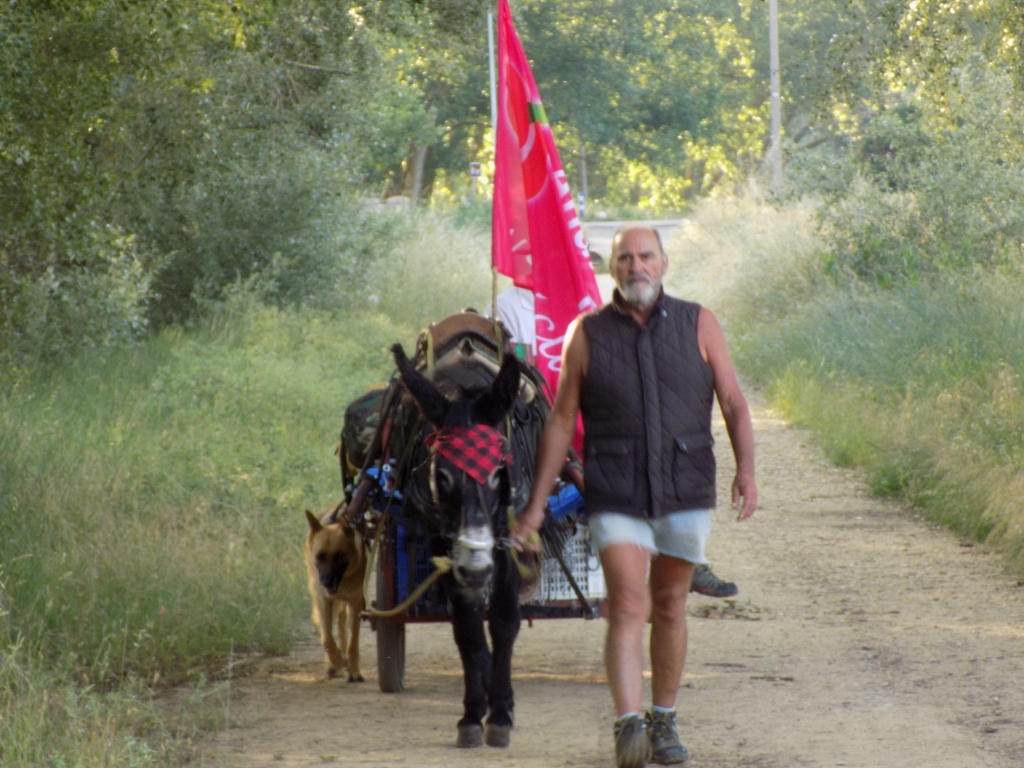 It is possible to do the pilgrimage in different ways
It is possible to do the pilgrimage in different ways
Before entering village Villacázar de Sirga, the Way passes by a dovecot. In Palencia province, there are more than 900 dovecots and these are examples of traditional local architecture. These are relatively big constructions, most often made of adobe, with different ground plan and shapes and their purpose was to support the family economy in two ways – they were used to get young pigeons, as well as good quality fertiliser. This approach to pigeon breeding has been used since the Roman times. The dovecot we stopped to visit dates back to the 19th century.
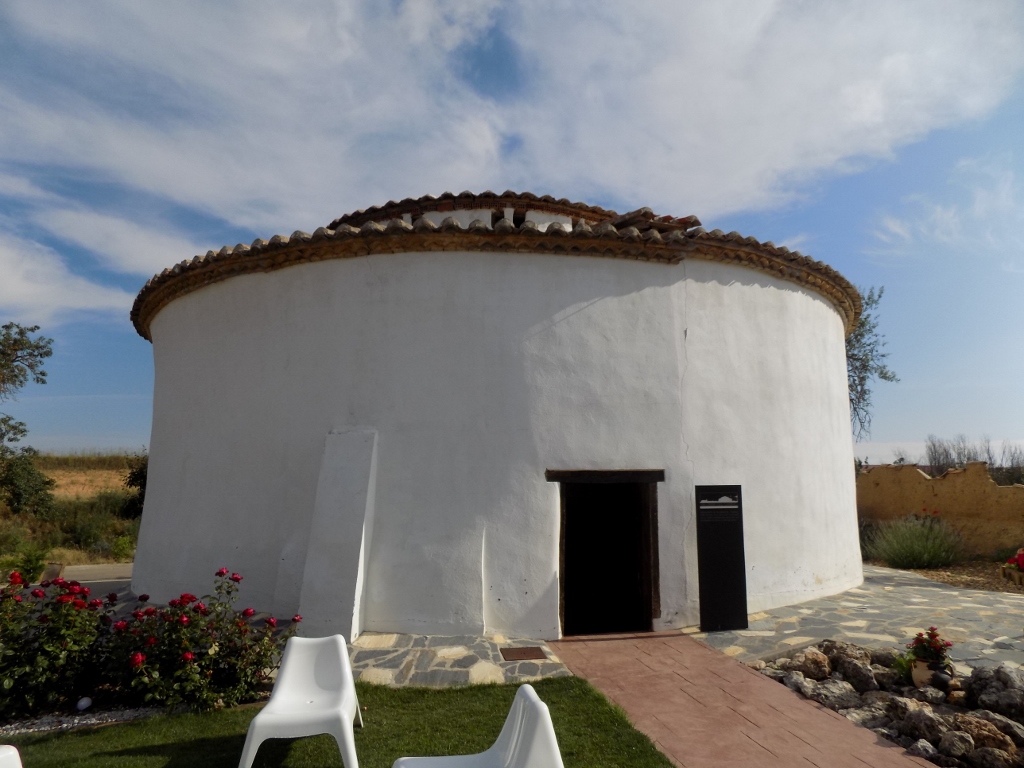 A dovecot
A dovecot
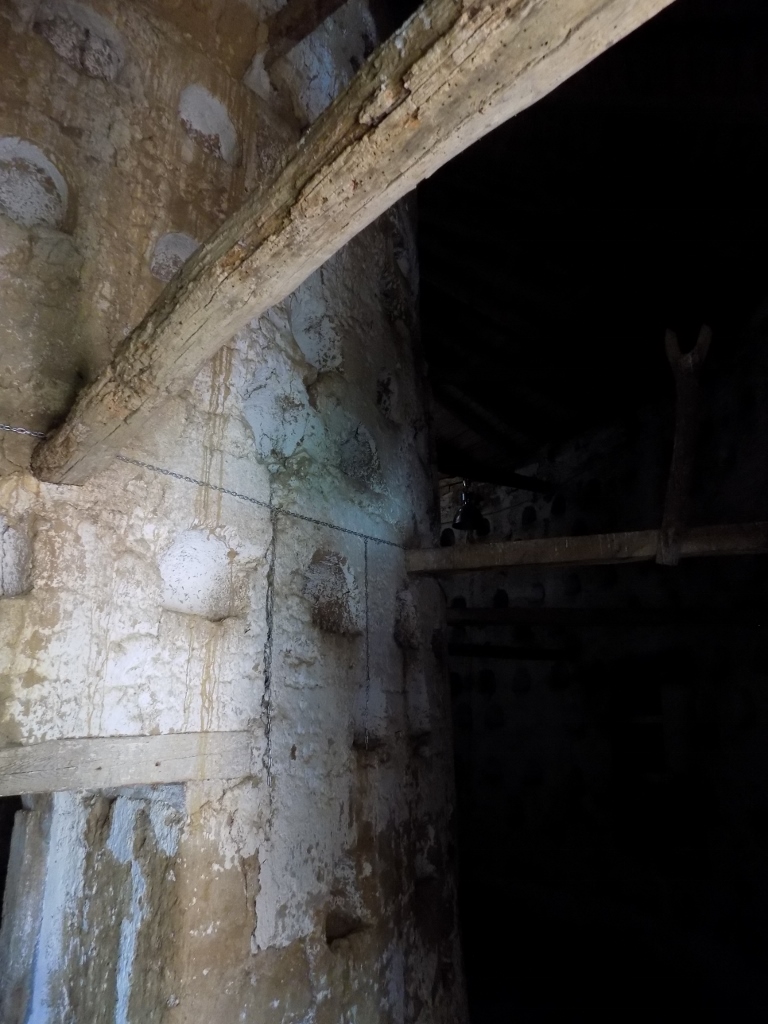 Interior of a dovecot
Interior of a dovecot
Village Villacázar de Sirga, i.e., its centre, was completely impressive with its Church of Santa María la Blanca, built during the period 12th-14th century, as well as with some other buildings, but apart from a break during which we refreshed ourselves with a drink in one of the bars, I simply had no strength to do any sightseeing. Still, even the tiredness and painful legs did not prevent me from having a photo with my friends taken.
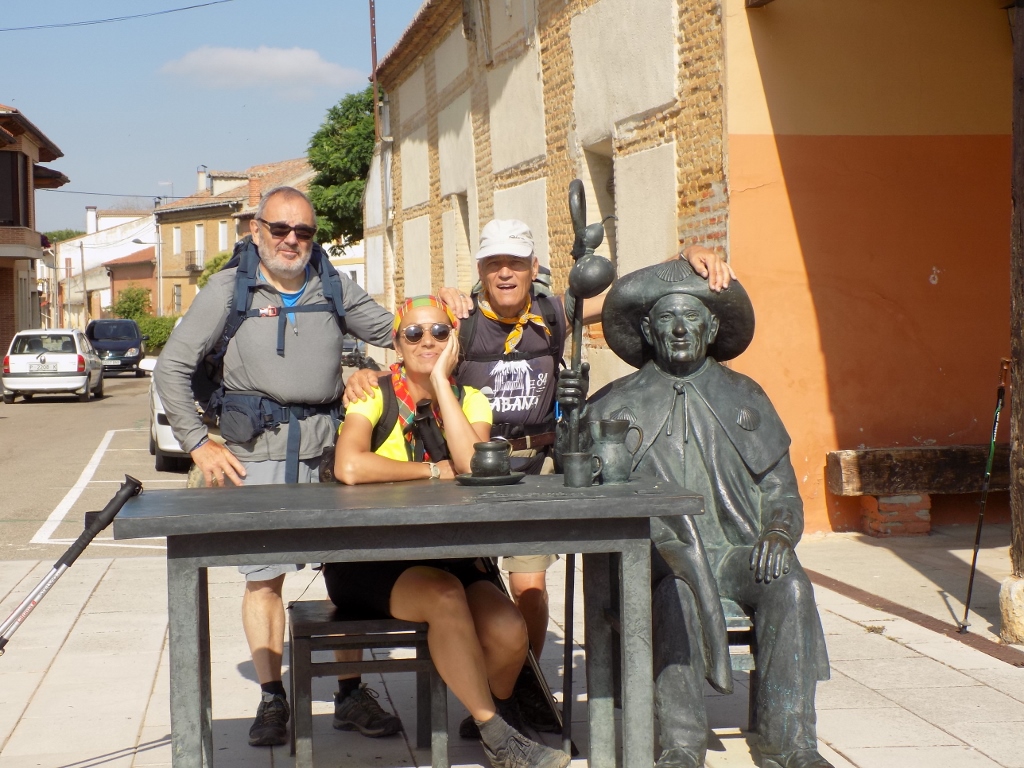 Striking a pose in Villacázar de Sirga
Striking a pose in Villacázar de Sirga
Six kilometres farther, we came to town Carrión de los Condes and there we stayed at one of the parish albergues that offer accommodation solely to pilgrims. It was one of the best places we stayed at (everybody got a regular bed, not a berth, and each bed had wonderful, spotless, real cotton sheets) for only 5 euros!
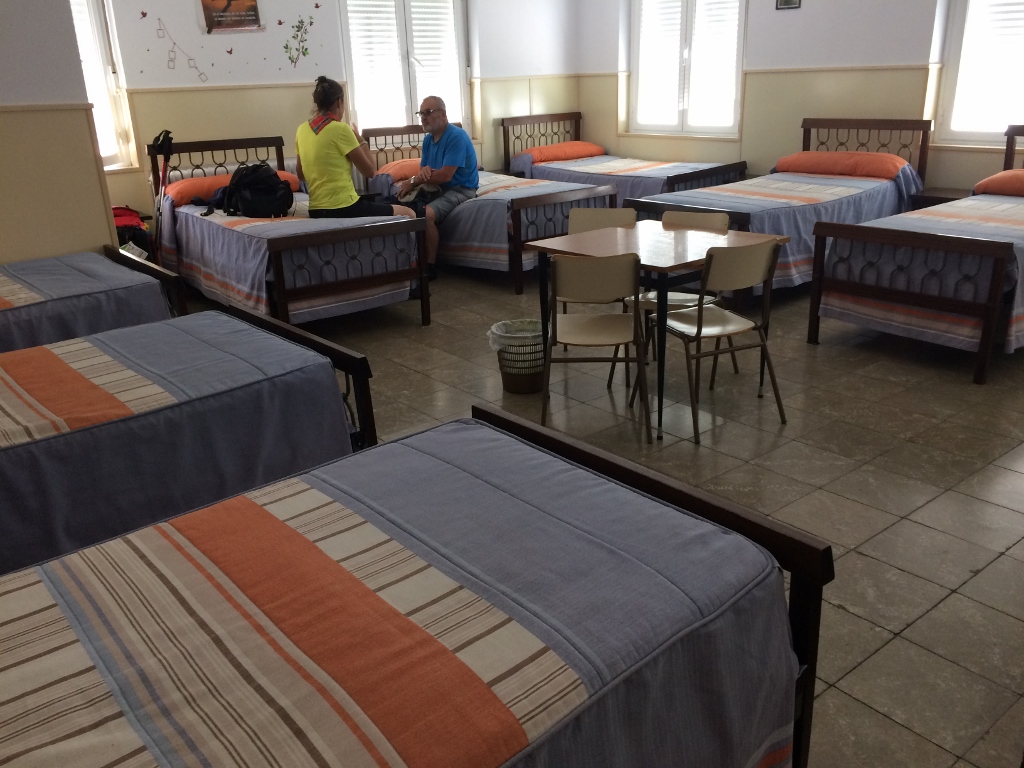 Making a deal before taking shower and washing laundry (Photograph courtesy of FT)
Making a deal before taking shower and washing laundry (Photograph courtesy of FT)
During the check-in process, I chatted a little with a volunteer host who was from England, so it was easy for me to communicate with him. He told me he had done pilgrimage several times and once he walked in rain for 10 days – he would get wet, then the rain would stop and he would get dry, then the rain would start again, and so on numerous times. On another occasion, he walked in snow, and once he was caught up in hail. I just thought how lucky I was, since the weather was mostly fine, in terms that the temperatures were not too high, while rain was also a rarity and it had never rained while we were walking. Admittedly, since I was walking in the middle of the European summer, even when the temperatures were not too high, already at the end of the morning, out in the open, with no shade, the Sun burned mercilessly and then it was not pleasant to walk and to get exhausted.
That host also told us that a mass for pilgrims would be held at the nearby Church of Santa María del Camino in the evening and a little later Francesco and I agreed we would go to the mass together.
Still, before all of that, I had my shower, lay down in the wonderful bed to have rest and also posted a new text.
Day 19: “Mathematics”
We were a little “late” this morning, but that was only because we had planned to cover less than 20 km, so we left at 6.30 and I slept in until 6 am (back at home I would just turn in bed at this hour).
Today’s day is important for many reasons and somehow they all come down to math and figures. Today, I covered the half of the Way in terms of the number of kilometres. The same goes for Francesco, since he had also started from Somport pass. But, naturally, everything in this life is relative and thus one of these days Gabriel started with his last quarter, since he had commenced his pilgrimage back in Arles, France, and that route is around 1,800 km long. A few days ago, we met a young German, 22 years, who had been walking for over 80 days – he had left from his place close to Munich. So, there are options, one just needs to start. And, so we have a new lesson:
Lesson no. 7: If you do not make the first step, you will get nowhere.
But, let me go back to the math. Today, I also entered the second half in terms of the time. According to the plan, I have 17 days left before I get to Santiago de Composela. It will not be the end of this journey, but it will be the end of the Pilgrimage.
And finally, since I’m throwing figures around, let me mention that regardless of the breaks and coach transfers, I did walk quite a lot. So far – 271 km!
In front of me: 419 km
Behind me: 448 km